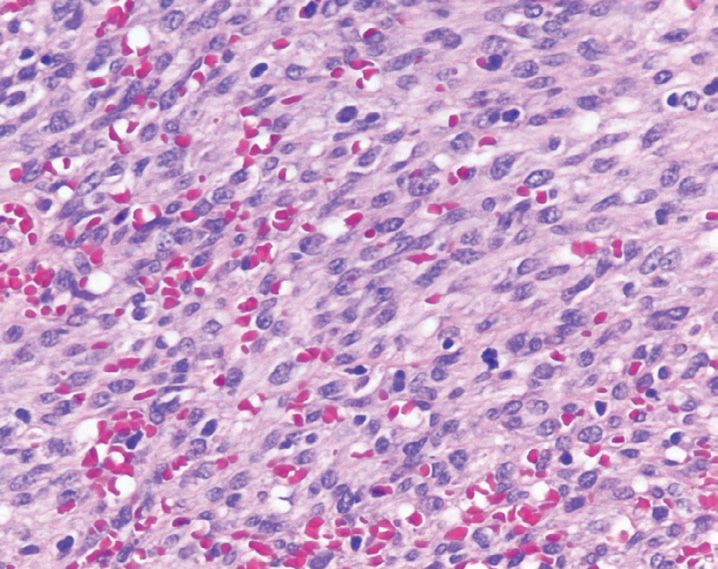FIGURE 3-1
(A) Endocarditis
(B) Gastroesophageal reflux disease
(C) Malabsorption syndrome
(D) Pulmonary hypertension
(E) Synovial hyperplasia
15. A 6-month-old baby boy presents with recurrent bacterial sinusitis, otitis media, and pneumonia. His workup reveals a marked decrease in peripheral B-lymphocytes, plasma cells, and serum immunoglobulins. The pediatrician suspects that this baby most likely has which of the following disorders?
(A) Bruton agammaglobulinemia
(B) Common variable immunodeficiency
(C) DiGeorge syndrome
(D) Hyper-IgM syndrome
(E) Severe combined immunodeficiency
16. A 17-year-old female presents with chronic diarrhea, malabsorption, and recurrent sinusitis. Based on the duodenal biopsy findings (see Figure 3-2), this patient most likely has
(A) Adenosine deaminase deficiency
(B) Complete absence of B-cells
(C) Hypogammaglobulinemia
(D) Low levels of circulating T-cells
(E) Mutation in either CD40 or its ligand
17. DiGeorge syndrome is characterized by all of the following except
(A) Failure of development of the fourth and fifth pharyngeal pouches
(B) Loss of cell-mediated immunity
(C) Poor defense against fungal and viral infections
(D) Tetany
(E) 22q11 deletion
18. Which of the following disorders is characterized by thrombocytopenia, eczema, and recurrent infections, and follows an X-linked recessive pattern of inheritance?
(A) DiGeorge syndrome
(B) Hyper-IgM syndrome
(C) Severe combined immunodeficiency
(D) Wiskott–Aldrich syndrome
(E) X-linked agammaglobulinemia
19. The most commonly used enzyme-linked immunosorbent assay (ELISA) targets which of the following components of the human immunodeficiency virus 1 (HIV-1) virion?
(A) p7
(B) p9
(C) p17
(D) p24
(E) gp120
20. Which of the following antigens is involved in the initial step of HIV infection?
(A) p7
(B) p9
(C) p17
(D) p24
(E) gp120
21. A 25-year-old man develops cytomegalovirus (CMV) retinitis. Which of these is the closest estimate of his CD4+ T-lymphocytes cell count?
(A) 40 cells/μL
(B) 90 cells/μL
(C) 200 cells/μL
(D) 350 cells/μL
(E) 600 cells/μL
22. A nodular skin lesion from a 25-year-old man with history of intravenous drug abuse is shown in Figure 3-3. This lesion is associated with which of the following viral infection?
(A) Epstein–Barr virus
(B) Herpes simplex virus
(C) Human herpesvirus 8
(D) Human papilloma virus
(E) JC virus
23. Which of the following lesions is not associated with human herpes virus-8 (HHV-8) infection?
(A) Kaposi’s sarcoma
(B) Multicentric Castleman’s disease
(C) Multiple myeloma
(D) Nasopharyngeal carcinoma
(E) Primary effusion lymphoma
24. A 65-year-old woman undergoes an endomyocardial biopsy that is shown in Figure 3-4. The histochemical stain of choice is
(A) Congo red
(B) Movat
(C) Periodic acid-Schiff (PAS)
(D) Reticulin
(E) Trichrome
25. The hemodialysis-associated systemic form of amyloidosis is associated with which of the following amyloid proteins?
(A) AA
(B) Aβ
(C) Aβ2m
(D) AL
(E) ATTR
ANSWERS
1. (A) Antibodies.
Innate immunity (also known as natural or native immunity) and adaptive immunity are the two broad categories of defense against infectious pathogens. The major components of innate immunity are epithelial barriers that block entry of microbes, phagocytic cells (including neutrophils, macrophages), dendritic cells, natural killer (NK) cells, and many plasma proteins including complement proteins. Inflammation is an important cellular reaction in which the phagocytic cells are recruited to recognize microbial components. The antiviral defense is mediated by dendritic cells and NK cells. In contrast, lymphocytes and their products, such as antibodies, are a major component of adaptive immunity, which develops after exposure to microbes, and is more powerful than innate immunity.
2. (A) Constitute 60–70% of lymphocytes in peripheral blood.
T-lymphocytes constitute the majority (60–70%) of the circulating peripheral lymphocyte population. They develop from precursors in the thymus (remember T = thymus, B = bone marrow). T-cells recognize specific cell-bound antigens via an antigen-specific T-cell receptor (TCR) that is noncovalently linked to CD3 complex and ζ chains that initiate activating signals. Following antigenic stimulation, it is the B-lymphocytes that develop into plasma cells, which secrete antibodies. Follicles within a lymph node are rich in B-lymphocytes, while T-lymphocytes are localized to the paracortical region.
3. (D) TCR diversity is generated by germline rearrangement of TCRα and β genes.
TCR diversity is generated by somatic rearrangement, and not germline rearrangement of genes that encode TCRα and β chains. All cells in our body, including lymphocyte progenitors, contain TCR genes in a germline configuration, and it is only the T-cells that undergo TCR gene rearrangement during their development in thymus. Thus, presence of rearranged TCR genes serves as a marker of T-cell lineage. Furthermore, each T-cell and its progeny have a unique DNA rearrangement, which makes it possible to distinguish polyclonal (non-neoplastic) T-cell proliferations from monoclonal (neoplastic) proliferations.
4. (A) They are expressed on all nucleated cells and platelets.
Stay updated, free articles. Join our Telegram channel

Full access? Get Clinical Tree





